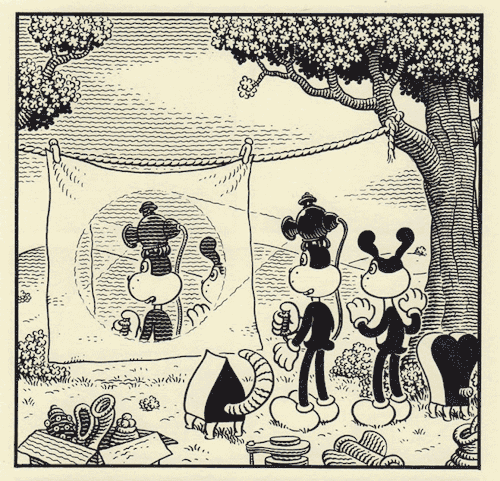Palookaville #21
by Seth
-This was really good. There's the next Clyde Fans installment, some "Rubber Stamp Diaries," and a beautiful autobio story about all the places he's lived, in his "sketchbook style."
I want to say something about the rubber stamp diaries.
Seth often draws autobio comics, and one day he had the idea to make rubber stamps of a few standard drawings of himself that he could use and re-use in his diary comics. Once he came up with the idea and intended to stick with it, he committed himself to a certain kind of form of comics. It is a good fit, because in a sense he had already committed himself to a certain kind of life, with certain types of concerns, and a comic book life where his tools are old technologies. His work is about an out-of-date business, centered on an out-of-date technology, the kind of business where rubber stamps were probably used in the office every day.
The rubber stamp in a formal comics context is paradoxical. It means that what is literally an “impression” made by the same object, what is literally a “rubber stamp” of itself, now becomes read as a returning over and over to the same view of the same “thing.” Yet it is also transformed into a new thing with each new impression. It changes not only in the sense that the quality of the image changes—little white bubbles appear, things like that—but also through taking their places within a network/system of comics panels, with different captions, and different relationships to the whole comic in which they appear.
(For anyone that has studied epistemology since Kant and Locke this all sets up an obvious, straightforward metaphor of one way of understanding how the mind works. "Sensory impressions" on a "blank slate." I don’t want to get into all that here, but I want to just mention that this metaphor, while certainly useful in many situations, is still highly artificial and should not be mistaken for its opposite, for non-metaphorical reality.)
The metaphor of a “rubber stamp” image in a comics context can be understood as meaning both a thing that does not change, panel to panel, and yet does change, because each panel is different. Each panel is a different moment, a different thought. So we could say: Seth commits to a comic book life where very little changes (he remains in the past, he tries to hold onto the past, in style and in his costume and his mind, via nostalgia, the beauty of “the banquet hall deserted”) yet there is always change, time always moves forward—this is built into the formal system of comics, like into the railroad tracks he walks, but through the use of the rubber stamp (and in his work in general) Seth tries to beat comics/time at its own game.
He takes walks, he concentrates his thoughts on some object. He moves his thoughts into the past, he thinks about the passage of time while moving through time, yet always glancing longingly backwards at the past, at his dark comfortable house and studio, which I suppose we could obviously say is a womb or at least “childhood”—the long days of aimless play, the “concerns” of games instead of the “real” concerns of “adulthood.”
In “Ghost” he walks outside and feels the present moment as timeless (this happens in several other strips, and ironically becomes a motif). The present moment is felt as connected to “all such similar moments in the past” (but not the future?). That night he dreams of his mother, and then he hears the train and imagines he’s still out there, on the tracks, but as a ghost, and the train passes through him. All the strips are about this struggle with time, to somehow grasp the present moment in its freedom and joy. But paradoxically this has to take place through the mediation of the objects around us—factories, trees, railroads—that clearly obviously have a past and point to that past, but somehow also seem themselves, like eternal things stamped on the present moment, the present panel.
An ultimate extreme of this form of comics could be imagined as a nostalgic comic, drawn in an “old timey” style, with rubber stamped images, which is nostalgic but also aware of this nostalgia, and rejects itself, both as form and as content, rejects the use of rubber stamps, yet uses them anyway, always searching for a more pure version of itself.
I have tried to represent this feeling of timelessness in the present moment in my own comics, especially in “
Time Travelling” in Ganges 1. There I use the metaphor of the seeing behind the comics panel, of 2D becoming 3D, to try to get at the sense of being both in and out of time. Several John Porcellino comics also come to mind, such as in “Mountain Song,” one of my favorite comics of all time, where the last line seemingly comes at us out of nowhere and re-frames everything that came before and the whole world from the perspective of this kind of “transcendent” feeling, to see behind what we can see.

